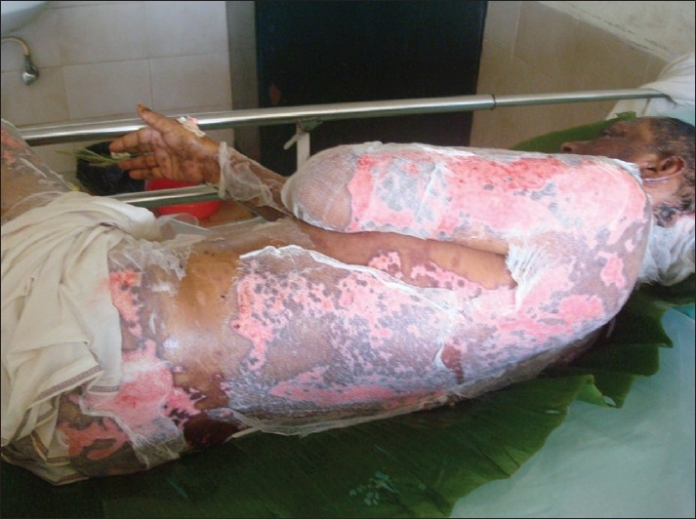38-year-old male patient presented with signs of fever and progressive generalised eruption, diagnosed with toxic epidermal necrolysis.
A 38-year-old Asian Indian male patient presented with toxic epidermal necrolysis. The patient complained of fever with progressive generalised eruption. He was also diagnosed with secondary generalised complex seizure 3 weeks before his the eruptions and was prescribed carbamazepine, 100 mg twice daily with slow-up titration of the dose to 300 mg twice daily.
On the 18th day of being on carbamazepine, the patient developed blisters on the trunk, chest and arms, associated with fever and headache. The patient consulted a local ayurvedic doctor for the lesions and was prescribed ayurvedic medication. Later, fluid filled lesions developed over the patient’s body, eyes, mouth and genitalea. Moreover, he also complained of breathlessness. Although, he did not have any family history of skin disease.
Patient also had breathlessness. He had no personal or family history of skin diseases.
Physical examination showed hypotension with systolic blood pressure of 90 mm Hg and tachypnoea with respiratory rate of 50/minute. The skin showed generalised peeling on physical examination with crusting seen over the body including the scalp and genitelea. The patient was afebrile with Nikolsky sign. The erythematous rash covered the entire body
The eryhtematous rash covered almost the entire body. Whereas, 70% of the body showed epidermal detachment. Nikolsky’s sign was positive. There was a loss of eyelashes, congestion of the conjunctiva with discharge of mucopurulent type and exposure keratitis. There were no signs of hepatosplenomegaly or lymphadenopathy.
The patient was diagnosed with toxic epidermal necrolysis induced by carbamezapine. Carbamezapine was immediately stopped and the patient was given a high dose of intravenous betamethasone, fusidic acid and mupirocin. Moreover, the patient’s tachypnoea worsened and he was put on prophylactic mechanical ventilation.
The erosions were covered with sterile paraffin gauge after being smeared with fusidic acid and betamethasone. The patient was made to lie down on a sterile banana leaf so his skin does not stick to the cotton bed. Topical antibiotic preparations (ciprofloxacin, gentamicin, chloramphenicol, moxifloxacin+dexamethasone) were used for treatment of the eye lesions. Furthermore, the eyes were covered with sterile pads soaked in saline. The patient was further prescribed supportive treatment with parenteral opioids for management of pain, intravenous albumin and fluids.
For nutrition, the patient was administered protein powder preparation through Ryle’s tube. On the fourth day of admission, the patient was started on levetiracetam for complex partial seizures. Moreover, once the lesions started healing, he was switched to oral betamethasone. The medication was slowly tapered and stopped after 4 weeks.
By the third week of the illness, the lesions had healed with post-inflammatory inflammation. The general condition of the patient improved after a month. However, examination showed hypertrophic scars on follow-up.
References
Carbamzepine-induced toxic epidermal necrolysis https://www.ncbi.nlm.nih.gov/pmc/articles/PMC3145298/




